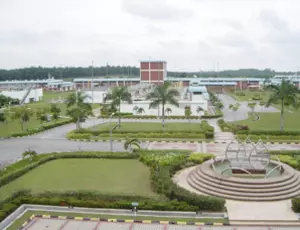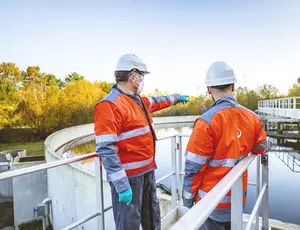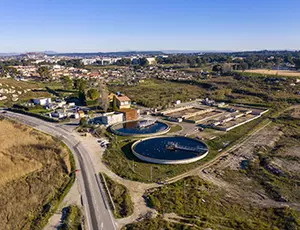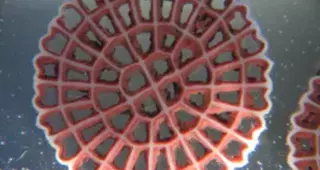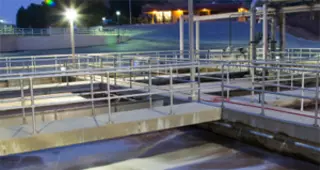Moving bed biofilm reactor for cost-efficient removal of pollutants from municipal and industrial wastewater. High efficiency for BOD, ammonia and nitrogen removal.
Overview
The Moving Bed Biofilm Reactor (MBBR) solution by AnoxKaldnesⓇ — a subsidiary of Veolia Water Technologies — is a biological process where biofilm grows on carriers suspended in wastewater.
This biological wastewater treatment and biological water treatment process treats pollutants in a cost-efficient way and it is used across almost all municipal and industrial market sectors such as food and beverage, mining, oil and gas, and pulp and paper. AnoxKaldnes provides MBBR based solutions that specifically address the customer, application and market.
MBBR is a stand-alone system which means there is no need for sludge recirculation, leaving only surplus biomass to be removed through downstream separation technology.
Reactors can be used for aerobic, anoxic or anaerobic processes MBBR technology offers the following advantages:
- Compact footprint
- Simple to operate
- Flexibility in choice of downstream separation
- Robust and stable with influent changes
- East to retrofit to existing infrastructure
MBBR biofilm technology is commonly applied:
- To small or remote operation municipalities
- When upgrading or retrofitting medium-sized plants to increase performance
- During tertiary applications where effluent quality is a priority
- In drinking water applications for low concentration removals
- At large plants requiring a minimum footprint
- To industrial applications where:
- Production changes challenge conventional treatment.
- Simple operation and robustness provide added security.
- Complex compounds require advanced treatment.
A packaged MBBR solution, MBBR Pack, is suited to certain municipal or industrial applications. These cases are often characterised by small flows, seasonal operations and/or remote locations.
MBBR Pack combines the expertise of two Veolia Water Technologies business units: AnoxKaldnes, known for its Moving Bed Biological Reactor (MBBR) systems, and PMT, specialized in standard product manufacturing and containerized solutions. It's designed within a standard 40-foot high-cube container, offering a compact and efficient solution for small to medium-sized municipal and industrial wastewater projects. It is suitable for wastewater, pre and post-treatment and water reuse. The containerized design ensures easy transportation, quick delivery and installation and it can handle up to 600 kilograms of chemical oxygen demand per day within 25 to 35 square meters.

Features and benefits
- Compact footprint
- Simple to operate
- Helps ensure a more sustainable and economical approach to production
- Flexibility in choosing downstream separation
- Robust and stable with influent changes
- Easy to retrofit to existing infrastructure

Compact footprint

Simple to operate

Helps ensure a more sustainable and economical approach to production

Flexibility in choosing downstream separation

Robust and stable with influent changes

Easy to retrofit to existing infrastructure
Applications
Services
We offer a range of services from process support contracts, laboratory trials and microscopy.
We also provide:
Product range and Resources
MBBR Pack
Combine expertise from two subsidiaries: AnoxKaldnes (MBBR systems) and PMT (standard manufacturing, containerized solutions). Housed in a 40-foot container, it offers a compact, efficient solution for small to medium wastewater projects, handling up to 600kg COD/day with easy transport, quick delivery, and installation.
AnoxKaldnes specialized MBBR solutions:
Contact
AnoxKaldnes MBBR based solutions combine decades of microbiological expertise and practical application to bring application and customer specific solutions to the market. Working with our experts ensures that your biological treatment needs are addressed with a holistic approach.

Brandy Nussbaum
Sales Director
FAQ about AnoxKaldnesⓇ MBBR
What is a moving bed biofilm reactor (MBBR) solution?
MBBR is a solution for biological treatment where biofilm grows on carrier elements that remain in constant motion in the treatment reactors.
What makes moving bed biofilm reactor (MBBR) technologies cost-efficient?
The carrier elements inside an MBBR allow for biofilm growth that results in an overall biological treatment step that is much smaller and more efficient than conventional systems such as activated sludge. The resulting reduced footprint saves on space, resources and civil construction which are all positive directions for the environment. Often MBBR systems are retrofitted into existing infrastructure which save on the investment for new civil construction as well as the points mentioned above.
Case Studies
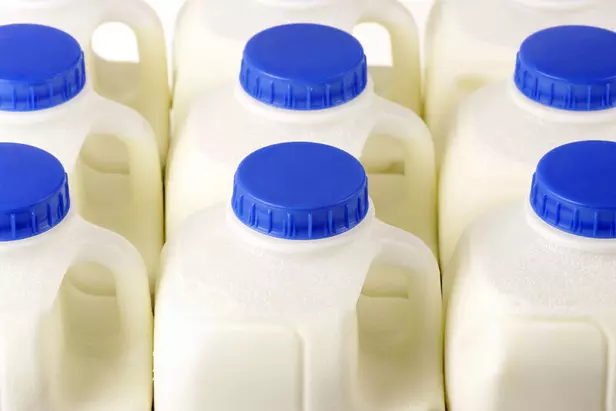
The existing wastewater treatment system was an extended aeration activated sludge process designed for 8,620 kg/d of biochemical oxygen demand but this was being overloaded at times to 13,600 kg/d during spill events in the factory. To correct this, Leprino invested in a MBBR treatment system to complement its existing treatment system and ensure stable operation. The MBBR has removed an average of 56% of the soluble chemical oxygen demand in the load from the wastewater and downstream activated sludge system has significantly improved operation, using less mechanical aeration, polymer for settling and anti-foam in aeration basins.

The wastewater treatment plant (WWTP) was running out of capacity with its previous activated aludge and clarifier treatment line and at the same time it was facing increasing and varying loading conditions. A combination solution to reach an overall capacity of 52,000 people equivalent, featuring Hybas, was chosen because it allowed for maximum flexibility and efficiency in a very small footprint. The space saving on the agricultural farms land outside the plant was also key.



